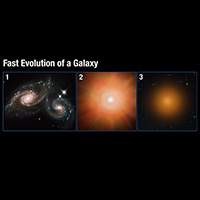 Astronomers have debated for decades how massive galaxies rapidly evolve from active star-forming machines to star-starved graveyards. Previous observations of these galaxies reveal geysers of gas shooting into space at up to 2 million miles an hour. Astronomers have suspected that powerful monster black holes lurking at the centers of the galaxies triggered the gaseous outflows and shut down star birth by blowing out any remaining fuel. Now an analysis of 12 merging galaxies at the end of their star-birthing frenzy is showing that the stars themselves are turning out the lights on their own star-making party. This happened when the universe was half its current age of 13.7 billion years.
"Before our study, the common belief was that stars cannot drive high-velocity outflows in galaxies; only more powerful supermassive black holes can do that," explained Paul Sell of Texas Tech University in Lubbock, lead author of a science paper describing the study's results. "Through our analysis we found that if you have a compact enough starburst, which Hubble showed was the case with these galaxies, you can actually produce the velocities of the outflows we observed from the stars alone without needing to invoke the black hole." Team member Christy Tremonti of the University of Wisconsin-Madison first identified the galaxies from the Sloan Digital Sky Survey as post-starburst objects spouting high-speed gaseous fountains. The sharp visible-light views from Hubble's Wide Field Camera 3 show that the outflows are arising from the most compact galaxies yet found. These galaxies contain as much mass as our Milky Way galaxy, but packed into a much smaller area. The smallest galaxies are about 650 light-years across. In such small regions of space, these galaxies are forming a few hundred suns a year. (By comparison, the Milky Way makes only about one sun a year.) This makes for a rowdy party that wears itself out quickly, in only a few tens of millions of years. One reason for the stellar shutdown is that the gas rapidly heats up, becoming too hot to contract under gravity to form new stars. Another possibility is that the star-birthing frenzy blasts out most of the star-making gas via powerful stellar winds. For a little more insight into the project see this: http://hubblesite.org/newscenter/archive/releases/2014/48/full/ |
